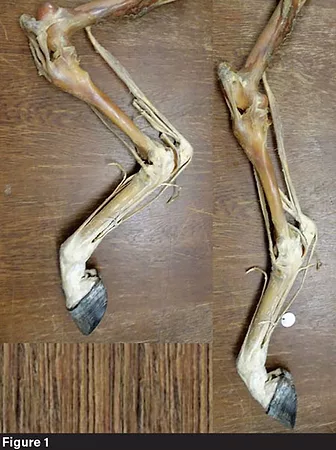American Farriers Journal
American Farriers Journal is the “hands-on” magazine for professional farriers, equine veterinarians and horse care product and service buyers.

Connection of all joints of the hind limbs by tendons and ligaments to synchronize flexion and extension during stance and motion. Photo by: Jenny Hagen
The swing phase describes the period of a gait cycle in which the limb has no contact with the ground.1 This phase can be divided into single parts. The different components of the locomotor system experience specific load during the different phases of swing phase.2 Prior to lift-off of the limb, the kinetic energy, stored during stance phase in the elastic structures of the limb, such as myofascial tissue and long tendons, is released to provide a passively supported and efficient push-off of the limb.3 Thereby, locomotion of the limb to swing phase is initiated
The front limbs are connected only by connective tissue and muscles to the thorax and optimal movement of the limbs during swing phase is dependent on function of the shock absorbing and energy storing myofascial system. In the hind limbs, the motion of all joints is synchronized by connection with long and elastic tendons, providing enormous forward momentum (Figure 1).
The first part of the pendulum phase is the retraction of the limb. It lasts from breakover until the fetlock is perpendicular under the elbow joint.1 During this phase, the limb is passively moved due to the release of the elastic energy. Subsequently, the limb passively commutes around the scapula. The mid of swing phase is the so-called hovering of the limb. During this phase, the limb is maximally flexed. Timing-wise, this occurs in the first third until passing of the contralateral limb.